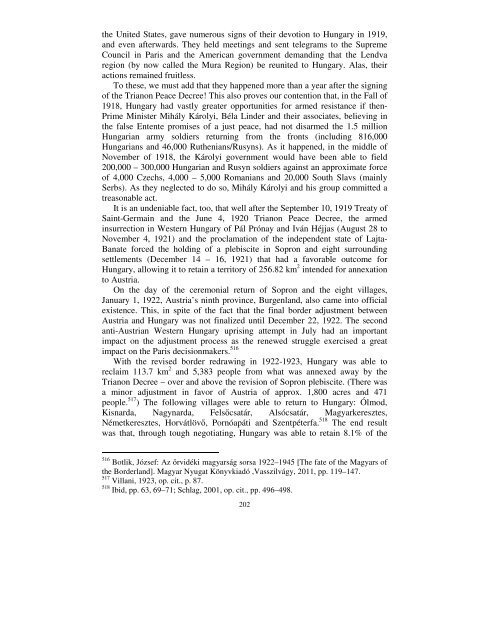The Fate of Western Hungary 1918-1921 - Corvinus Library ...
The Fate of Western Hungary 1918-1921 - Corvinus Library ...
The Fate of Western Hungary 1918-1921 - Corvinus Library ...
You also want an ePaper? Increase the reach of your titles
YUMPU automatically turns print PDFs into web optimized ePapers that Google loves.
the United States, gave numerous signs <strong>of</strong> their devotion to <strong>Hungary</strong> in 1919,<br />
and even afterwards. <strong>The</strong>y held meetings and sent telegrams to the Supreme<br />
Council in Paris and the American government demanding that the Lendva<br />
region (by now called the Mura Region) be reunited to <strong>Hungary</strong>. Alas, their<br />
actions remained fruitless.<br />
To these, we must add that they happened more than a year after the signing<br />
<strong>of</strong> the Trianon Peace Decree! This also proves our contention that, in the Fall <strong>of</strong><br />
<strong>1918</strong>, <strong>Hungary</strong> had vastly greater opportunities for armed resistance if then-<br />
Prime Minister Mihály Károlyi, Béla Linder and their associates, believing in<br />
the false Entente promises <strong>of</strong> a just peace, had not disarmed the 1.5 million<br />
Hungarian army soldiers returning from the fronts (including 816,000<br />
Hungarians and 46,000 Ruthenians/Rusyns). As it happened, in the middle <strong>of</strong><br />
November <strong>of</strong> <strong>1918</strong>, the Károlyi government would have been able to field<br />
200,000 – 300,000 Hungarian and Rusyn soldiers against an approximate force<br />
<strong>of</strong> 4,000 Czechs, 4,000 – 5,000 Romanians and 20,000 South Slavs (mainly<br />
Serbs). As they neglected to do so, Mihály Károlyi and his group committed a<br />
treasonable act.<br />
It is an undeniable fact, too, that well after the September 10, 1919 Treaty <strong>of</strong><br />
Saint-Germain and the June 4, 1920 Trianon Peace Decree, the armed<br />
insurrection in <strong>Western</strong> <strong>Hungary</strong> <strong>of</strong> Pál Prónay and Iván Héjjas (August 28 to<br />
November 4, <strong>1921</strong>) and the proclamation <strong>of</strong> the independent state <strong>of</strong> Lajta-<br />
Banate forced the holding <strong>of</strong> a plebiscite in Sopron and eight surrounding<br />
settlements (December 14 – 16, <strong>1921</strong>) that had a favorable outcome for<br />
<strong>Hungary</strong>, allowing it to retain a territory <strong>of</strong> 256.82 km 2 intended for annexation<br />
to Austria.<br />
On the day <strong>of</strong> the ceremonial return <strong>of</strong> Sopron and the eight villages,<br />
January 1, 1922, Austria’s ninth province, Burgenland, also came into <strong>of</strong>ficial<br />
existence. This, in spite <strong>of</strong> the fact that the final border adjustment between<br />
Austria and <strong>Hungary</strong> was not finalized until December 22, 1922. <strong>The</strong> second<br />
anti-Austrian <strong>Western</strong> <strong>Hungary</strong> uprising attempt in July had an important<br />
impact on the adjustment process as the renewed struggle exercised a great<br />
impact on the Paris decisionmakers. 516<br />
With the revised border redrawing in 1922-1923, <strong>Hungary</strong> was able to<br />
reclaim 113.7 km 2 and 5,383 people from what was annexed away by the<br />
Trianon Decree – over and above the revision <strong>of</strong> Sopron plebiscite. (<strong>The</strong>re was<br />
a minor adjustment in favor <strong>of</strong> Austria <strong>of</strong> approx. 1,800 acres and 471<br />
people. 517 ) <strong>The</strong> following villages were able to return to <strong>Hungary</strong>: Ólmod,<br />
Kisnarda, Nagynarda, Felsőcsatár, Alsócsatár, Magyarkeresztes,<br />
Németkeresztes, Horvátlövő, Pornóapáti and Szentpéterfa. 518 <strong>The</strong> end result<br />
was that, through tough negotiating, <strong>Hungary</strong> was able to retain 8.1% <strong>of</strong> the<br />
516 Botlik, József: Az őrvidéki magyarság sorsa 1922–1945 [<strong>The</strong> fate <strong>of</strong> the Magyars <strong>of</strong><br />
the Borderland]. Magyar Nyugat Könyvkiadó ,Vasszilvágy, 2011, pp. 119–147.<br />
517 Villani, 1923, op. cit., p. 87.<br />
518 Ibid, pp. 63, 69–71; Schlag, 2001, op. cit., pp. 496–498.<br />
202
















